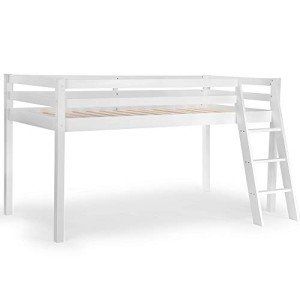5 Laws That Can Help To Improve The Bunk Beds Industry
Exploring Bunk Beds: A Comprehensive Guide
Bunk beds have long been a staple in children's bed rooms, dorms, and even homes with restricted space. Toddler Bunk Beds do they provide a practical sleeping service, however they also produce an enjoyable and creative environment for children and a great space-saver for adults and households. This article will explore everything you require to understand about bunk beds, from types and products to safety suggestions and purchasing suggestions.
Table of Contents
- Kinds Of Bunk Beds
- Standard Bunk Beds
- Loft Beds
- Triple Bunk Beds
- L-Shaped Bunk Beds
- Product Options
- Wood
- Metal
- Safety Considerations
- Purchasing Guide
- FAQs
Kinds Of Bunk Beds
Bunk beds come in numerous designs to suit different needs and preferences. Here's a breakdown of the most typical types:
Conventional Bunk Beds
Conventional bunks normally feature 2 beds stacked vertically on top of one another. These beds are perfect for brother or sisters sharing a space or for making the most of sleeping space in guest rooms.
Loft Beds
Loft beds stand likewise to conventional bunk beds but do not have a lower sleeping area. Instead, they frequently integrate a desk or seating location underneath, making them a great choice for little rooms needing multifunctionality.
Triple Bunk Beds
Triple bunk beds are created for 3 occupants, with beds stacked in a three-tier setup. Toddler Bunk Beds are less typical but can be an enjoyable option for big households or slumber parties.
L-Shaped Bunk Beds
With one bed positioned horizontally and the other vertically, L-shaped bunk beds are frequently equipped with extra features such as desks or storage drawers and can match corner spaces in a room.
Contrast of Bunk Bed Types
Bed Type
Ideal Use
Description
Standard
Shared bed rooms or visitor rooms
Two beds stacked vertically
Loft
Small spaces needing multi-purpose space
Upper bed with open space below
Triple
Big families or pajama parties
Three beds stacked vertically
L-Shaped
Corner or flexible spaces
A mix of vertical and horizontal beds
Material Options
Bunk beds are made from numerous materials, with wood and metal being the most common. Each product has its pros and cons.
Wood
- Sturdiness: Generally robust and can hold up against years of use.
- Aesthetic Appeal: Offers a classic look that can mix with numerous decors.
- Weight Capacity: Typically tougher; can support much heavier weights.
- Drawbacks: May be more costly than metal options and can be prone to scratches.
Metal
- Sturdiness: Generally lightweight and simple to move however still sturdy.
- Modern Design: Often comes in smooth designs, making it appealing for contemporary spaces.
- Economical: Usually cheaper than wooden choices.
- Disadvantages: Can be cold to the touch in winter seasons and may not have the exact same visual appeal for some purchasers.
Safety Considerations
When it comes to bunk beds, security can not be ignored. Here are crucial safety ideas to keep in mind:
- Guardrails: Ensure that the leading bunk has guardrails on both sides to avoid falls.
- Sturdy Construction: Check for a solid construct and strong products to endure weight and movement.
- Weight Limit: Adhere to the producer's weight limitation for both the upper and lower bunks.
- Ladder Design: Choose bunks with a safe, easy-to-climb ladder and prevent any sharp edges or rungs.
- Age Restrictions: Most manufacturers advise that children under the age of 6 ought to not oversleep the upper bunk.
Buying Guide
When looking for bunk beds, consider the following aspects to find the best fit for your needs:
- Space Availability: Measure the space size and ceiling height, making sure there is adequate space for the top bunk.
- Bed Size: Decide between twin, full, or bigger sizes based on your requirements and the size of the space.
- Design Preference: Consider the total decor of the bed room to discover an appropriate design.
- Relieve of Setup: Look for a bunk bed that is uncomplicated to put together.
- Budget: Bunk beds are available in different rate varieties, so identify a spending plan before beginning your search.
Frequently asked questions
1. What is the suggested age for kids to sleep on the leading bunk?
Children aged 6 and older are typically advised to sleep on the leading bunk to reduce the threat of falls.
2. How can I make my bunk bed much safer?
To improve safety, guarantee guardrails are properly set up and inspect that the bed is put on a flat surface area. Additionally, encourage kids to utilize the ladder thoroughly.
3. Can I transform a bunk bed into 2 different beds?
Lots of bunk beds are designed to be convertible. Check the manufacturer's specs for convertibility functions.
4. What devices are readily available for bunk beds?
Common devices include bed linens, storage drawers, staircases instead of ladders, and tented canopies for an enjoyable visual appeal.
5. How do I maintain my bunk bed?
Routine checks for loose screws or structural stability can assist ensure safety. Dust the bed frequently and clean spills immediately to keep the products in good condition.
Bunk beds are flexible and a space-efficient service for various living situations, from kids's rooms to guest accommodations. With lots of styles and products available, prospective purchasers have a wealth of options to think about, making sure a mix of functionality and aesthetic appeals. By prioritizing security and following the pointers laid out in this guide, people can find the right bunk bed that fits their space and lifestyle, all while developing a pleasurable sleeping environment.
